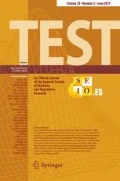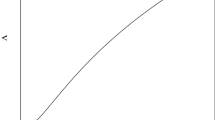Summary
Consider a Normal likelihood with unknown mean and variance and consider a prior given by the product of a Student-t for the mean and a non-informative prior for the variance. The resulting posterior for the mean is proportional to the product of two Student-t densities. Approximations are given for the posterior moments of such a density by recalling the fact that the Student-t is a scale mixture of Normals and performing appropriate Taylor expansions. Extensions in can be obtained for a one-way random effects model and its applications in meta-analysis.
Similar content being viewed by others
References
Abrams, K. R. and Sansó, B. (1995a). Approximate Bayesian inference for random effects meta-analysis.Statistics in Medicine (to appear).
Abrams, K. R. and Sansó, B. (1995b). Model discrimination in meta-analysis—a Bayesian perspective.Tech. Rep., Universidad Simón Bolivar, Caracas.
Angers, J.-F. (1992). Use of the student-t prior for the estimation of normal means: A computational approach.Bayesian Statistics 4 (J. M. Bernardo, J. O. Berger, A. P. Dawid and A. F. M. Smith, eds), Oxford: University Press, 567–575.
Berger, J. O. (1985).Statistical Decision Theory and Bayesian Analysis, 2nd edn, New York: Springer-Verlag.
Box, G. E. P. and Tiao G. C. (1973).Bayesian Inference in Statistical Analysis. Reading, Massachusetts: Addison-Wesley.
Dawid, A. P. (1973). Posterior expectations for large observations.Biometrika 60, 664–666.
Fan, T. H. and Berger, J. O. (1992). Behaviour of the posterior distribution and inference for a normal mean witht prior distributions.Statistics and Decisions 10, 99–120.
Gelfand, A. E. and Smith, A. F. M. (1990). Sampling-based approaches to calculating marginal densities.J. Amer. Statist. Assoc. 85, 398–409.
Jonhnson, M. F. (1993). Comparative efficacy of NaF and SMFP dentrifices in caries prevention: a meta-analytic overview,Caries Research 27, 328–336.
Lindley, D. V. (1971). The estimation of many parameters.Foudations of Statistical Inference (V. P. Godambe and D. A. Sprott, eds.), Toronto: Holt. Rinehart and Winston, 435–355.
O’Hagan, A. (1979). On outlier rejection phenomena in Bayes inference.J. Roy. Statist. Soc. B 41, 358–367.
Pericchi, L. R. and Sansó, B. (1995). A note on bounded influence in Bayesian analysis.Biometrika,82, 223–225.
Pericchi, L. R. and Smith, A. F. M. (1992). Exact and approximate posterior moments for a normal location parameter.J. Roy. Statist. Soc. B 54, 793–804.
Sansó, B. and Pericchi, L. R. (1995). On near ignorance classes.Revista Brasileira de Probabilidade e Estadistica 8, 119–126.
Tierney, L. and Kadane, J. (1986). Accurate approximations for posterior moments and marginal densities.J. Amer. Statist. Assoc. 81, 82–86.
Whitehead, A. and Whitehead, J. (1991). A general parametric approach to the meta-analysis of randomized clinical trials.Statistics in Medicine 10, 1665–1677.
Author information
Authors and Affiliations
Rights and permissions
About this article
Cite this article
Sansó, B. Simple approximations for location and ANOVA models with non-conjugate priors. Test 6, 119–126 (1997). https://doi.org/10.1007/BF02564429
Received:
Revised:
Issue Date:
DOI: https://doi.org/10.1007/BF02564429




